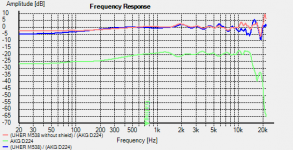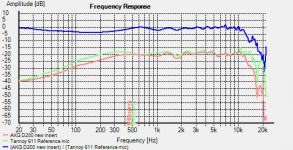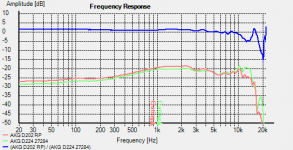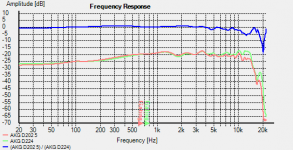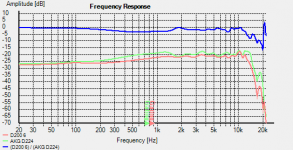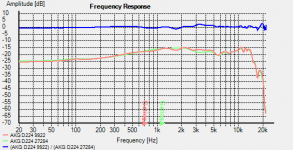There doesn't seem to be a slot on the forum for microphones . . . so here goes.
I'm trying to do some reasonable recordings. TS5 CM60 Framkenmic UHER M538 AKG D202 AKG D224 is a test of five microphones. Which is best?
Many thanks
Best wishes
David P
I'm trying to do some reasonable recordings. TS5 CM60 Framkenmic UHER M538 AKG D202 AKG D224 is a test of five microphones. Which is best?
Many thanks
Best wishes
David P
Last edited:
I like UHER ( Assmann Electronics group -Germany ) a German company while most companies use overseas for the actual manufacture I think its still manufactured in Germany any that are not I know they send production engineers to that country to supervise the quality.
AKG Germany( bought by Harman USA but now owned by Samsung ) but manufacturing is overseas .
Don,t know the first one but I do know UHER .
AKG Germany( bought by Harman USA but now owned by Samsung ) but manufacturing is overseas .
Don,t know the first one but I do know UHER .
Mics are not like speakers, you use different mics for different sources. Micing a guitar amp is very different then micing a vocal. What are you using it for?
I'm using them for a recording of which the video is the same sample from each of the five pairs of mics. . . .
Best wishes
David P
Best wishes
David P
Really helpful. Thanks so much.
The CM60 is clinical but wonder if the high frequencies are on steroids - monosodium glutamate. I wonder if the violin becomes abrasive rather than smooth.
Then there's competition between D224, UHER M537 and D202 . . .
Many thanks for thoughts
Best wishes
David P
The CM60 is clinical but wonder if the high frequencies are on steroids - monosodium glutamate. I wonder if the violin becomes abrasive rather than smooth.
Then there's competition between D224, UHER M537 and D202 . . .
Many thanks for thoughts
Best wishes
David P
I compared it on my R-2R DAC. With CM60 the violin details raised a bit and at the same time it is not disruptive - it sounds more real. The piano also has cleaner details and is way better in dynamics.
for studio recording a condenser microphone is better, for stage and loud recordings is widely used a dynamic mic (it needs a louder sound, it is more resistant to external interference - wind)
Hi David,
Since you've got so many mics, why not mic the violin separately from the piano? The results might be better --- as it is, the violin isn't loud enough in the mix in my opinion. How were the instruments arranged and where were the mics placed?
Since you've got so many mics, why not mic the violin separately from the piano? The results might be better --- as it is, the violin isn't loud enough in the mix in my opinion. How were the instruments arranged and where were the mics placed?
Yes - interesting thought. And professionally quite right. But I'm a bit of a stick in the mud for natural sound, sound as it is, faults and all - and this was probably the balance we experienced in real life. Perhaps I might have boosted the left channel a bit.
The mics were a standard ORTF configuration but at 90 degrees rather than 110
www.youtube.com/watch?v=mnTDkj5dYYc was done with a pair of D202 and into which I mixed probably around 10% of the Frankenmic which was placed about 2ft below the D202 pair.
YouTube was done with a UHER M538 and a AKG D200 as a pair, the responses being similar, and not dissimilar to the D202



Best wishes
David P
The mics were a standard ORTF configuration but at 90 degrees rather than 110
www.youtube.com/watch?v=mnTDkj5dYYc was done with a pair of D202 and into which I mixed probably around 10% of the Frankenmic which was placed about 2ft below the D202 pair.
YouTube was done with a UHER M538 and a AKG D200 as a pair, the responses being similar, and not dissimilar to the D202
Best wishes
David P
Attachments
Last edited:
David,
The "real life balance" depends on where you are in the hall. And any mic is going to have a different frequency response than your ears, making the assessment of what's "natural" to be very subjective.
From what I hear, the mid-side Frankenmic sounds by far the most "realistic." In large part, this is due to a more realistic channel separation. The other mics seem to be too much of an unrealistic left/right separation from what I hear. The mid-side has better mix of direct sound and hall sound in my opinion too. Since I wasn't there, I don't know if it is truly "realistic" or not. When mixing mid-side, you have to make some decisions on the relative subtraction/mix, correct? I like the results of whatever choices were made there vs. the other mic tracks. I've always been a fan of mid-side for small combos or singing groups, and the flexibility mid-side affords.
Second choice, (but a distant second to the mid-side) is the AKG d224, followed by the D202. The D202 has a very different sound to it, not unpleasant, but very different than any of the others. Reading about this mic, I find the descriptions of the bass/treble split and the "rear-entry slots" at the bottom of the mic very interesting. I'm wondering if this design is what is responsible for the very different sound of this mic.
Thanks for posting the recording of the different mics.
Cheers,
B B
The "real life balance" depends on where you are in the hall. And any mic is going to have a different frequency response than your ears, making the assessment of what's "natural" to be very subjective.
From what I hear, the mid-side Frankenmic sounds by far the most "realistic." In large part, this is due to a more realistic channel separation. The other mics seem to be too much of an unrealistic left/right separation from what I hear. The mid-side has better mix of direct sound and hall sound in my opinion too. Since I wasn't there, I don't know if it is truly "realistic" or not. When mixing mid-side, you have to make some decisions on the relative subtraction/mix, correct? I like the results of whatever choices were made there vs. the other mic tracks. I've always been a fan of mid-side for small combos or singing groups, and the flexibility mid-side affords.
Second choice, (but a distant second to the mid-side) is the AKG d224, followed by the D202. The D202 has a very different sound to it, not unpleasant, but very different than any of the others. Reading about this mic, I find the descriptions of the bass/treble split and the "rear-entry slots" at the bottom of the mic very interesting. I'm wondering if this design is what is responsible for the very different sound of this mic.
Thanks for posting the recording of the different mics.
Cheers,
B B
Thanks for your thoughts and observations. Really helpful.
The Frankenmic lacks the bass in my opinion. My son who's very into recording, and others, like the CM60. In my opinion this makes the violin abrasive rather than smooth.
The D202 and D224 are both similar in principle with treble and bass units and their difference in sound is interesting. The D200 is likewise as is the UHER M538 - so a family of mics.
When one is lucky these mics can be very flat, and the D200s going above their specified 10k but it's difficult to find them in good up-to-spec condition.




Other comments about how they sound are really appreciated. By the way, I upload to YouTube at the full 320bps sound resolution.
Best wishes
David P
The Frankenmic lacks the bass in my opinion. My son who's very into recording, and others, like the CM60. In my opinion this makes the violin abrasive rather than smooth.
The D202 and D224 are both similar in principle with treble and bass units and their difference in sound is interesting. The D200 is likewise as is the UHER M538 - so a family of mics.
When one is lucky these mics can be very flat, and the D200s going above their specified 10k but it's difficult to find them in good up-to-spec condition.
Other comments about how they sound are really appreciated. By the way, I upload to YouTube at the full 320bps sound resolution.
Best wishes
David P
Attachments
Last edited:
...
The D202 and D224 are both similar in principle with treble and bass units and their difference in sound is interesting.
...
David P
There could be an intermodulation distortion (IMD), when one frequency is measured equally on both devices, but the combination of several frequencies will be measured differently.
Try this software for some advanced simulations and measurements:
PRAXIS INFORMATION
IMD can be affected/modified by instrument placement, by different shapes of mic enclosure around input, by placing mic in angles, recording room size and walls, ... 😀
Last edited:
Best 'value': Takstar CM-60
Best presence and low end: UHER
Best separation and timbre: Frankenmic
Best clarity in mids: AKG D224, although a bit 'thin' overall
Best presence and low end: UHER
Best separation and timbre: Frankenmic
Best clarity in mids: AKG D224, although a bit 'thin' overall
Last edited:
Best presence and low end: UHER
Presence? I hear a ton of hiss in the right channel of that UHER recording
Presence? I hear a ton of hiss in the right channel of that UHER recording
Hmmm - I had a problem with the pair. For some reason one of my Large Tuchel conversion leads goes to a DIN plug and I'm using another conversion lead and this lead is giving trouble leading to a 6dB loss of signal. So I had to apply extra gain on that channel - this is a fault not representative of the mic, but I quite like the overall sound that it gives.
Best wishes
David P
Yes - "authority" is a good description which is why I quite like the UHER. The M537 is a single diaphragm so in the class of the respected Sennheiser MD421
Best wishes
David P
Best wishes
David P
You say you like natural sound. Real violins don't sound smooth. The AKG D200 and D224 makes things sound smooth. I would suspect the weight of voice coils to be responsible. Wider bandwidth microphones such as capacitor microphones will usually give a result closer to the real thing.
A single pair of microphones is challenged when more that one source is being recorded. It is usually best to achieve balance between the sources and eq to a rendition that suits you. This might mean moving the artists which is not possible in a performance setting.
Regardless, each mic has its unique signature. Choose one that fits and be prepared for post production.
I repair microphones and between myself and my buddy have access to more than 30 microphones (lost count) including D224 and 3 versions of D200. If it is not drums we use capacitors.
A single pair of microphones is challenged when more that one source is being recorded. It is usually best to achieve balance between the sources and eq to a rendition that suits you. This might mean moving the artists which is not possible in a performance setting.
Regardless, each mic has its unique signature. Choose one that fits and be prepared for post production.
I repair microphones and between myself and my buddy have access to more than 30 microphones (lost count) including D224 and 3 versions of D200. If it is not drums we use capacitors.
- Home
- Source & Line
- Analogue Source
- Expert ears needed for microphone comparisons
